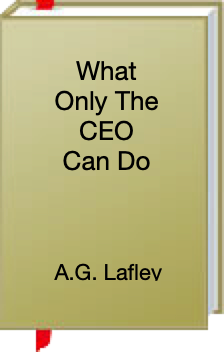By A.G. Lafley
What is the primary work of a CEO and how does the chief executive ensure that work gets done? Former Procter & Gamble CEO A.G. Lafley tells us what and shows us how in "What Only the CEO Can Do." This work is eight pages of diamonds buried in a leadership mine of books and resources.
The day Lafley took the helm at P&G in June 2000, the company stock fell $26 a share. That summer it lost $85 billion in market capital. Lafley was not responsible for the losses, but it was his job to stop the bleeding and return the company to health. He did just that. I share this because reading "What Only the CEO Can Do?" is to sit with a weathered leadership captain, one who has navigated his ship through stormy seas.
And what is the essential job that only the CEO can do? It is this:
The CEO links the outside world (society, economy, technology, customers) with the inside world (your organization) (p.1).
Lafley gleaned this insight from an unfinished work by Peter Drucker that the Wall Street Journal published in 2005. Drucker said, "The CEO is the link between the Inside that is 'the organization,' and the Outside of society, economy, technology, markets, and customers. Inside there are only costs. Results are only on the outside."
While understanding the whatis critical, it is understanding and doing the how that brings about real change:
1. Define the meaningful outside: The CEO must determine who or what is the primary constituency the organization serves. For P&G, it was the consumer.
2. Decide what business you're in: Drucker said, "Equally important--and also a task only the CEO can fulfill--is to decide, 'What is our business? What should it be? What is not our business? And what should it not be?'" Lafley notes that determining one's business requires "continual pruning and weeding." I loved this: "Disposing of assets is not as sexy as acquiring them, but it's just as important." That hit home for me because programs can be sacrosanct in colleges and universities. It is hard for a college to prune -- and absolutely necessary.
3. Balance present and future: Leaders must determine (and it is an art and science) the optimal balance between "yield from present activities and investment in a highly uncertain future." He adds (and I have found this so true): "The pull will always be to the present, because the interests of most stakeholders are short-term" (6). To be prepared for the future, the leader must be intimately involved in leadership development.
4. Shape values and standards: Lafley differentiates between values (the behavior which establishes a company's identity) and standards (the expectations that guide decisions). While I think that a bit foggy, this line from Drucker was not: "CEOs set the values, the standards, the ethics of an organization. They either lead or they mislead" (7).
Conclusion and Recommendation:
Change -- internal and external -- is a part of the life cycle of every business. Drucker says that we don't manage it, we can only lead through it. To this Lafley adds, "The CEO is the only person who can appreciate both the inside and the outside. Consequently the majority of the CEO's time should be spent on the four tasks outlined here" (8).
As noted, this article is a gem, it a finely cut diamond which sparkles with insights and applications. Like Drucker's "Managing Oneself", Lafley's "What Only the CEO Can Do" should be -- for me anyway -- an annual read.
My takeaways:
1. Read: "What Business Are You In?" by Ted Levitt. Also read, Drucker, The Theory of Business . Lafley shared these two resources as an "editor's note" in the Audible version.
2. Invest in leadership development: Yes, I know this is the obvious, however Lafley's efforts in this regard are significant: He personally grooms people for the future. He knows the top 500 in the company and is involved in their development. He reviews their development plans, assessing strengths and weaknesses. He puts them in front of the board at key times in company life.
3. Leaders don't have to know it all: After walking into the firestorm that was P&G ($26 drop in share price in one day), Lafley was interviewed on TV. "Everyone was looking to me for answers, but the truth was that I did not yet know what it would take to get P&G back on track. Welcome to the job of CEO--a job I'd never done before" (2). So often people want to know -- right out of the gate -- "What's your vision?" Leader, you don't need to be pressured to provide an answer. It takes time.
4. Integrating the outside and the inside is hard. It is easier to pick one or the other, leaders must pay attention to both and "make the judgments and tough calls others are unable to make" (3).
5. Set aside time personally and organizationally to prune. "Determine which businesses we should not be in is an ongoing effort that calls for continual pruning and weeding. Disposing of assets is not as sexy as acquiring them, but it's just as important" (6).
6. More on leadership development: I must put leadership development at the front of my presidential responsibility list, clarify how I/we will work that out for our team. Clarify the plan, invite involvement, engage personally from design and teaching, and collaborate with others toward it. Lafley knows, he is personally involved, he reviews, he strategical places leaders in situations and places that will groom and showcase their efforts (See page 7).
7. Leading through change: Be sure to clarify what will NOT change while reorienting the team to the outside.
8. Establish clear metrics: Lafley addressed this under "Shaping Values and Standards." P&G, like GE, set the standard/metric for business performance. P&G business divisions had to be in the top third of their sector. He writes, "In the absence of explicitly defined standards, people will develop their own; that's human nature" (8).
9. Structural challenges: As LBC considers and moves toward a university model, structural integrity dictates that we consider how some schools will grow at different rates and plan accordingly (both with respect to strategy and expectations). Lafley's comments regarding similar challenges regarding product development and "payoff" were helpful (see page 7).


